Today I have a tutorial using the Pacific Leggings pattern. It has interesting details, yet it’s still quick to sew. (And they’re very comfortable to wear.)
One thing I wanted to demonstrate is how to sew stretchy, professional-looking seams on your Pacific Leggings. You can sew regular seams with a stretch stitch or narrow zigzag, or sew all seams on your serger. I came up with this way of finishing them and it’s a great way to have your leggings look like they were professionally manufactured!
You’ll often see a type of stitching called flatlock used on leggings and yoga pants. What is a flatlock? On athletic apparel, it’s a type of seam that is sewn on a special machine. It looks similar to serging with its multiple threads, but it’s sewn with one edge overlapped on top of the other.
We can create a similar look using regular sewing machines!
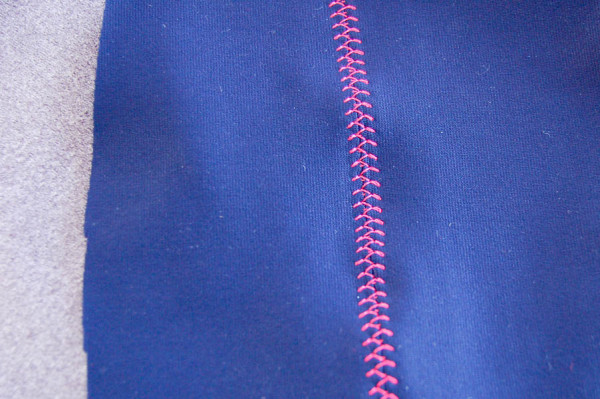
In my demo I’m using neon red thread so it shows up clearly on the navy fabric. For comparison I sewed a regular zigzag, a three-step zigzag, a stitch I refer to as ‘baseball stitch’ and a random other stitch that looks like it could stretch.
Test your chosen stitch on a scrap of fabric. Now stretch it! I stretched my little sample both lengthwise and widthwise to see what the stitching would do. If it stretches easily without restricting the fabric or snapping, it’s a good choice.
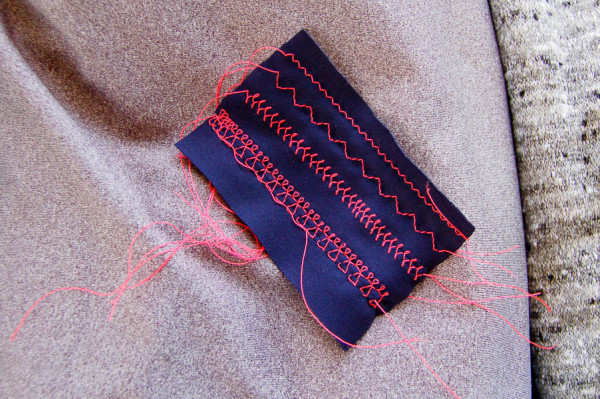
The baseball stitch is the one I’m going to use. It’s #13 in the photo below. This is a good stitch because there’s a lot of thread in it, going from side to side as well as down the seam. It’ll take a lot of stress on the seam for this one to snap! In comparison, the zigzags reach their maximum stretching potential well before the baseball stitch does. I can feel the resistance as the zigzag stitches straighten out.
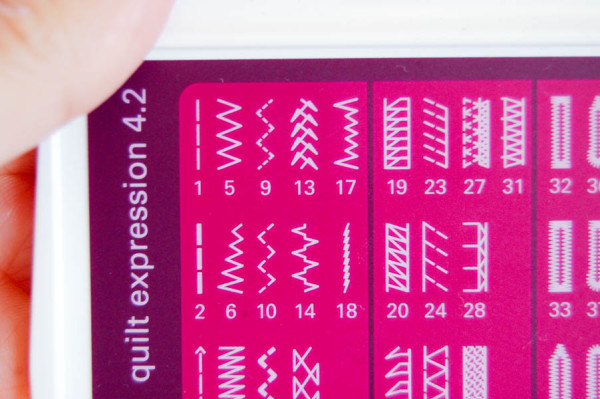
There are two steps to this process: sewing the seam, then topstitching on top of it to create the flatlock effect. Here’s how to do it!
1. Sew the Seam
I used a narrow zigzag stitch so the seam itself will stretch. On this demo, I’m sewing all seams in neon red thread, but if I were sewing a real pair of leggings I’d use navy for the regular seams and save the neon for visible stitching only.
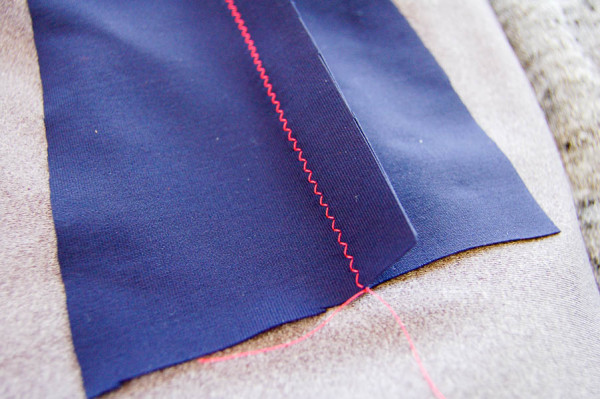
2. Press it Open
You can just use your fingers for a quick press and skip the iron. You’ll be holding the seam open when you sew it, so it’s not super important to press first.
3. Baseball Stitch down the Centre of the Seam
Center your stitching over the middle of the seam, so the baseball stitch covers both sides of the seam.
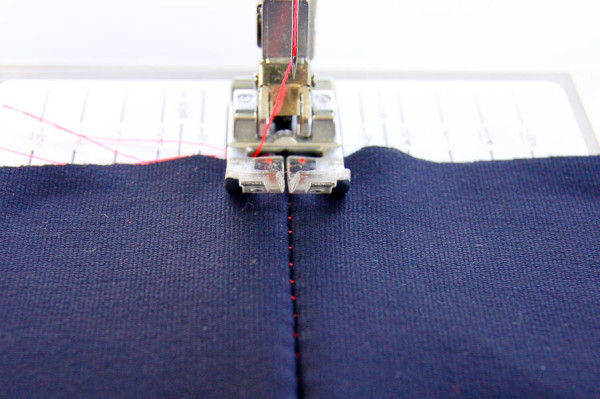
Look, a rare photo of both hands!

I wanted to show where to put your hands while sewing the seam. I’m stretching lightly across the seam with my hands, and stretching slightly from top to bottom with my thumbs as well. Kind of an allover stretch.
4. Trim Seam Allowance
Turn the piece over, and trim excess seam allowance on either side of the seam.
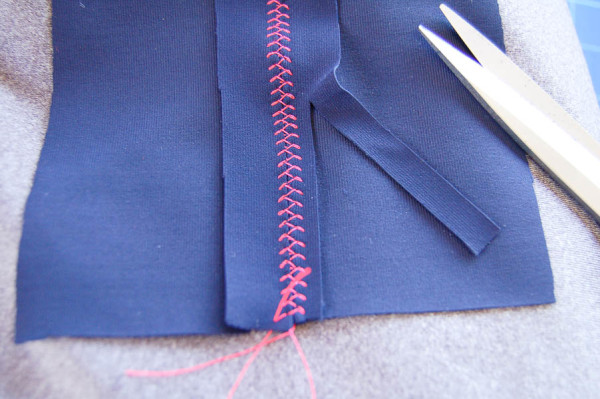
That’s it! It’s only one more step than sewing a plain seam but it adds visual interest to the seamlines, without restricting stretch or movement.
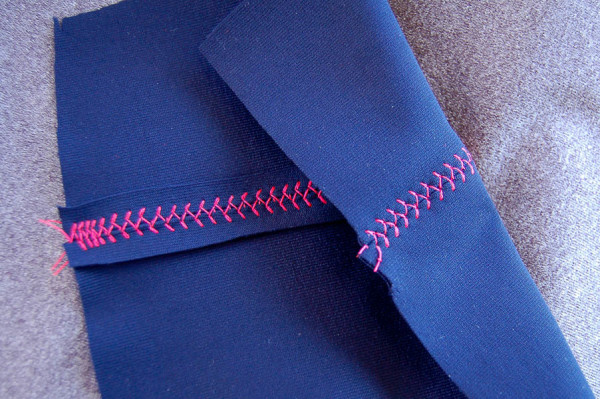
See how much it stretches! It stretches and recovers back to its original size. It has the appearance of flatlock, but you can do it on a regular home sewing machine.
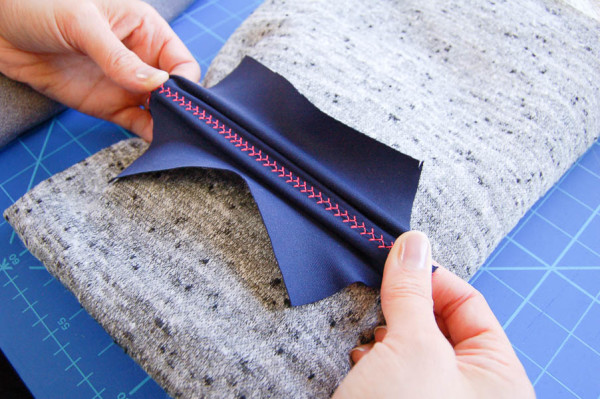
What if your machine doesn’t have this baseball stitch? You could use a zigzag stitch, a three-step zigzgag, or any stitch that is wide enough to cover both sides of the seam and has built-in stretch. Depending on how many stitch functions your machine has, the look will vary.
More Faux-Flatlock Tips
- The baseball stitch is directional, meaning it looks different if you sew down a seam, compared to sewing up the seam. Sew all your seams in the same direction for a consistent look.
- This stitch also looks identical on both sides of the fabric. This means you can sew your hems from the inside, if that’s easier for you, and it will look the same as if you’d sewn from the right side.
- If you’re using a contrast thread, you may be able to keep your bobbin threaded in matching thread. I switched both bobbin and top threads to red every time.. until I started to run out. Then I left the navy in the bobbin to make the red last as long as possible. I couldn’t tell the difference! This does mean you’ll have to always sew from the right side of your garment, but it can save time switching back and forth. (Unless you have two sewing machines. Then thread one in your main thread colour, the other in contrast.)
Specific Tips for the Pacific Leggings
- When topstitching the gusset and inner leg seam, sew from the front, pivoting to sew around one side of the gusset, then continue up the back seam. Then go back and sew the other angled side of the gusset. The stitching will overlap a bit at the starting and ending points but it won’t be super noticeable unless you’re using contrast thread.

Great useful tips! Many thanks.
Thanks, a great way to do these seams if you don’t have a flat locker. I will definitely give this a try.
Thanks for this great idea – even though I can do a flatlock seam on my machine I will use this stitch just for variaty.
What a timely tutorial! I was just thinking about this yesterday while shopping for raincoat fabric. This would probably work well with some of the outerwear fabrics I was dreaming projects for. Thanks!
Great tutorial! what kind of thread are you using? it looks thicker than regular thread.
It’s just regular, all-purpose Gutermann polyester thread. Just happens to be neon, so it stands out a lot more than if it matched the fabric. I still have the spool, it’s colour number 3837 if you like it!
You can do flatlock seems on a serger. The lower looper tension has to be set very loose and when the seam is finished you sttetch the two pieces and the lower piece will twist and flatten iut under the upper.
I’ve heard that though never tried it myself – thanks for sharing!
I love the look of this seam…Tasia your new collection is fabulous and I love that you’ve upped the standards for home sewing. This collection really looked like high end RTW
Thanks so much! That’s such a nice thing to say, and makes me happy as that was our goal with this collection, to have it look really professional and as good as store-bought.
If you have a baby lock serger, you can do a 3-thread flatlock too. Set it up with both the needle thread and the upper looper thread in the upper looper track. Put wrong sides together to see the serging stitches on the right side.
This is fabulous! Although I have sergers and coverstitch machines, I’m going to give this a try. I love the way it looks. Thank you!!!
I really enjoy this.
Fantastic tip!
Brilliant!! Really handy – I’d never thought of doing that. It gives a much more pro look to have even the fake flatlock there!
Thank you! I have had trouble trying to get this look in my fitness wear. First I serged, then tried to go over it with a coverstitch but the seam skipped stitches and became so thick and stretched out. I’m eager to try this on a tennis outfit I have cut out. Perfect timing!
I have never thought about doing this- thank you! I totally love it.
Do you have any tips for doing the inseam of leggings? I am just wondering how this would work once you get into the more narrow parts of the pant inseam (like around the knee area).
I love this look, great tip, thank you!
What sewing machine do you use?
This is really handy. Thanks for the tute.
Great to hear it! ;)